
The index page for the 1954 French flap section of this website is here.
Reference for this case: Beg-Nov-54-Saint-Germain-Lembron.
Please cite this reference in any correspondence with me regarding this case.
In 1956, in the magazine of his ufology group "CIE Ouranos", the first French ufologist, Marc Thirouin, published an article evaluating the possibility that some cases of the 1954 French wave could be explained by secret advanced planes.
On this occasion, he evoked an observation that was reported with a sketch in the newspaper La Liberté, of the Puy-de-Dôme, in early November 1954 by a correspondent of this newspaper who witnessed the phenomenon.
Marc Thirouin said that a dozen witnesses had seen above Saint-Germain-Lembron in the Puy-de-Dome a luminous object of elongated shape, which stood out clearly on the sky at the front, with symmetrical bulges at the upper and lower middle, and prolonged by a long trail, also luminous, rectilinear, horizontal, whose end melted into the night producing like sparks.
He says that the apparent dimensions of the "craft" and its speed at the time of observation were, it seems, roughly equivalent to those of a craft of 3 to 5 meters in length seen at a distance of 500 to 800 meters and flying at about 500 km/h. The "craft" was totally silent.
The trajectory was South-West to North-East, in the axis Biscarosse (Landes) - Bron (Rhône). The witness, with whom his departmental correspondent Clément Bigot made contact, said that the front of the "craft" seemed slightly tilted downward.
[Ref. ous1:] UFOLOGY MAGAZINE "OURANOS":
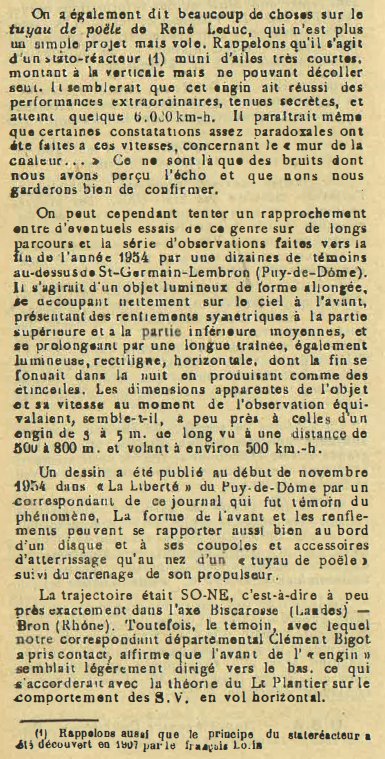
|
[...]
Much has also been said about René Leduc's stovepipe, which is no longer a simple started project but flies. Remember that it is a ramjet (1) with very short wings, rising vertically but that cannot take off alone. It seems that this machine has achieved extraordinary performance, kept secret, and would have reached some 6,000 km-h. It would even seem that some paradoxical observations have been made at these speeds concerning the "wall of heat..." These are just rumors we perceived the echo of, and that we will refrain from confirming.
We can, however, attempt a comparison between possible tests of this kind on long courses and the series of observations made towards the end of 1954 by a dozen witnesses over St-Germain-Lembron (Puy-de-Dôme). It was reported to be a luminous object of elongated shape, clearly visible against the sky at the front, presenting symmetrical swellings at the upper and lower middle, and extending by a long trail, also luminous, rectilinear, horizontal, whose end melted into the night, producing like sparks. The apparent dimensions of the craft and its speed at the time of observation were, it seems, roughly equivalent to those of a 3 to 5 m long craft seen at a distance of 500 to 800 m. and flying at about 500 km-h.
A sketch was published at the beginning of November 1954 in "La Liberté" of the Puy-de-Dôme by a correspondent of this newspaper who witnessed the phenomenon. The shape of the front and the bulges can relate as well to the edge of a disc and to its cupolas and landing gear as to the nose of a "stovepipe" followed by the fairing of its thruster.
The trajectory was SW-NE, that is to say almost exactly in the Biscarosse (Landes) - Bron (Rhône) axis. However, the witness, with whom our departmental correspondent Clément Bigot made contact, said that the front of the "apparatus" seemed slightly tilted downwards; which would agree with Lt Plantier's theory on the behavior of the FS in horizontal flight.
(1) Recall also that the principle of the ramjet was discovered in 1907 by the Frenchman Louis
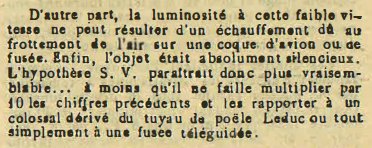
|
On the other hand, the luminosity at this low speed cannot result from a heating due to the friction of the air on an airplane or rocket hull. Finally, the object was absolutely silent. The F.S. hypothesis will therefore appear more likely... unless one multiplies by 10 the previous figures and report them to a colossus derived from the Leduc stovepipe or just a remote controlled rocket.
[...]
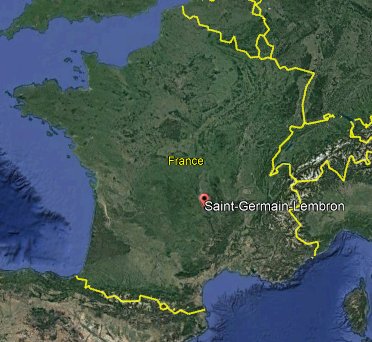
|
In his article, Marc Thirouin examined the possibility that the object seen at Saint-Germain-Lembron was the "Tuyau de Poële" ("Stivepipe") of engineer René Leduc; I want to situate things aeronautically speaking, since few people are aware of the achievements of René Leduc.
Born in 1898, deceased in 1968, Leduc, former Supélec student, filed a patent for the pulsed jet engine in 1930. It was the pulsed jet engine that propelled the German V1 the flying bombs during WW II.
In 1933, he filed the patent of the ramjet. There would be a first prototype using this system whose construction began in 1937, called Leduc 010. But the war interrupted the project before the craft was ready to fly.
Assisted by Louis Bréguet, Leduc fled to the free zone with his blueprints and continued the project in a small factory in Montaudran, without the Germans realizing it.
After the Liberation, the work continued and the Leduc 010 flew in 1949. This was the "stovepipe" to which Marc Thirouin alludes. A Leduc 021 flew at the Paris Air Show in 1955. The Leduc 022 will be the last of the series, flying between 1956 and 1957. The State cancelled its support and it was the end of the Leduc aircraft.
The principle of the conventional reactor is as follows: with a small electric motor, air is compressed into a combustion chamber in which kerosene is also spread then fired. The produced gases escape from the rear and push the aircraft, while rotating an axis that then drives the air compressor, so the small electric motor is not needed anymore.
The ramjet is just a pipe. Kerosene is spread and ignited in it. The problem, of course, is that there is nothing there to compress the air, nothing to just get the air necessary for combustion, into the pipe. So it cannot work that way. In flight, it would work since the air would naturally enter the pipe from the front. So, you have to be able to take off first by another mean. For this, Leduc designed two solutions: one was to take off his craft on the back of another plane, the other was simply to add a conventional jet engine to the machine, used just for the takeoff.
Leduc did it. It resulted in an absolutely exceptional machine in terms of speed of interception, an aircraft that would arrive on the enemy in record time, at a record speed. That's what interested the French Air Force. The problem was that the State was financing conventional jet planes (Ouragan, Mystère, then the famous Mirage, not to mention vertical take-off craft and the North Griffon ramjet plane, and it was concluded that there was not enough money to continue with the Leduc ramjet. Another problem was that the Leduc aircraft were incredibly fast but with very limited range, exhausting their fuel even faster than conventional jet fighters.
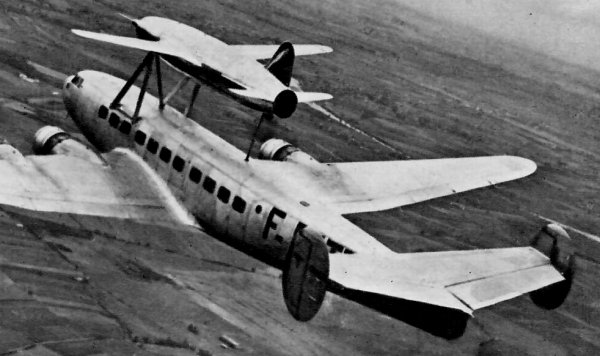
|
Above: The Leduc 010 on his Bréguet Languedoc mothership.
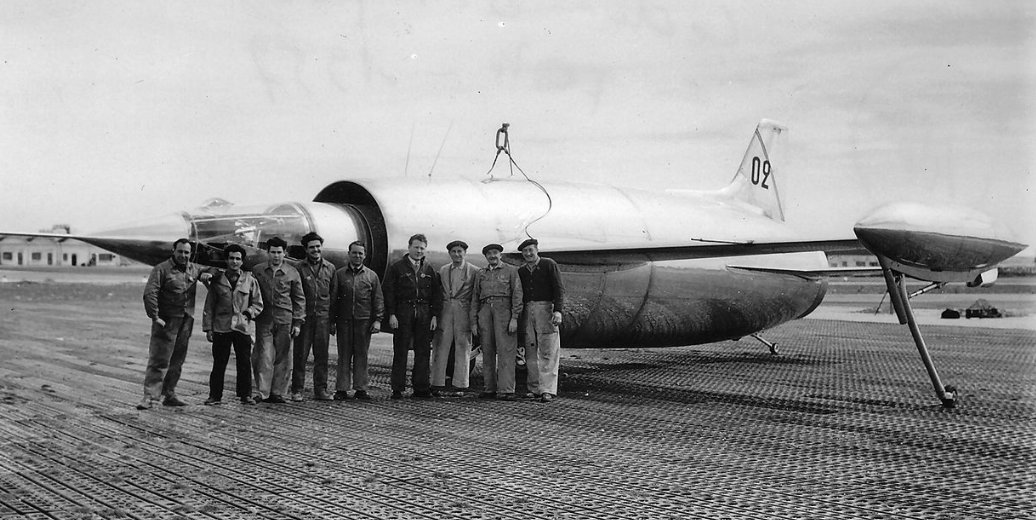
|
Above: The Leduc 021.
I want to immediately dispel the rumor mentioned by Marc Thirouin assuring that the "stovepipe" "would have reached some 6,000 km-h". Pure fantasy; the fastest Leduc aircraft will reach "only" Mach II (~2,400 km/h), which was quite considerable at the time.
If at the time one did not know too much when and where these planes could have flown, we know now. There were 774 flights (a good part of which was without dropping, with the "Leduc" remaining attached to its carrier aircraft). All flights from 1951 took place above the Istres base, except for some Leduc convoys hung on their carrier aircraft.
(The Leduc planes, however, were not "secret", they were seen by people before 1954 already in popular science magazines suc as Science & Life).
There were two Leduc 010. The first flew flights only between November 19, 1946 and July 25, 1952, and crashed on November 25, 1951. The second made its tests between March 14, 1950 and November 27, 1951, and crashed on November 27, 1951.
Only one Leduc 016 (similar to the Leduc 010 but with two turbojet boosters) was built, and was tested between 1951 and 1954.
Two prototypes of the Leduc 021 were built. They were able of reaching the speed of sound, they were tested in flight between 1953 and 1956, presented at the Paris Air Show in 1955, and scrapped.
The unique Leduc 022, capable of flying at Mach II, is the only one that did not require a carrier aircraft - it was equipped with a conventional additional jet engine and took off on its own, but it leeft the Argenteuil factory on June 5, 1956, and did not fly in 1954.
In fact, in 1954, there were only two flights:
So obviously the Leduc aircraft do not explain even a single case of the 1954 French "wave" of flying saucers...
You can see a Leduc 016 turned back into a Leduc 010, and the Leduc 022, at the Air and Space Museum of Bourget near Paris:
Tip: look "into" the nozzle of these gears: there is no axis, no compressor; the Leduc planes were really "stovepipes".
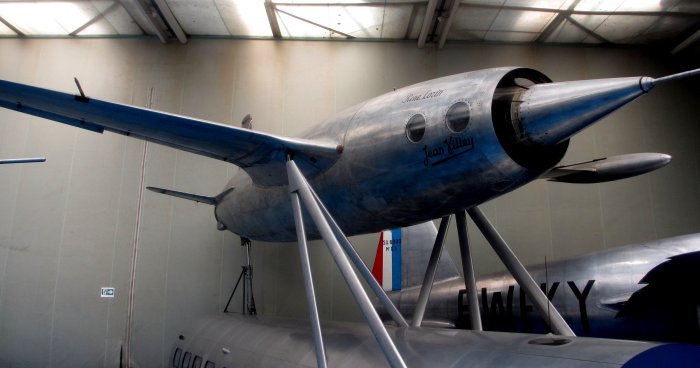
|
Above: The Leduc 016-02 repaired and re-transformed into "Leduc 010 03". Photo in 2014 by the author of this website.
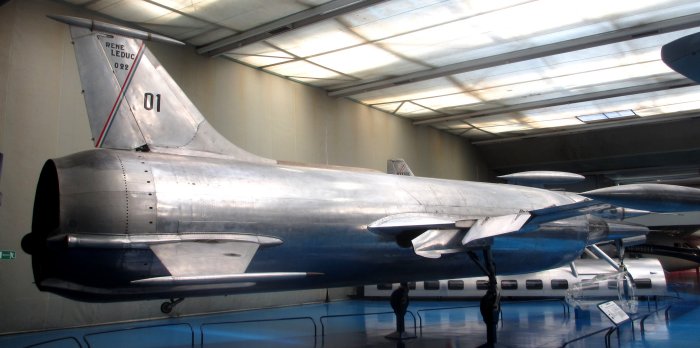
|
Above: The Leduc 022-01. Photo in 2014 by the author of this website.
Just reading the description makes it obvious that what was seen was perfectly similar to a meteor.
(These keywords are only to help queries and are not implying anything.)
Saint-Germain-Lembron, Puy-de-Dôme, luminous, trail, craft, multiple, elongated, bulges, rectilinear, horizontal, sparks
[----] indicates sources that are not yet available to me.
| Version: | Created/Changed by: | Date: | Change Description: |
|---|---|---|---|
| 1.0 | Patrick Gross | June 19, 2019 | First published, [ous1]. |